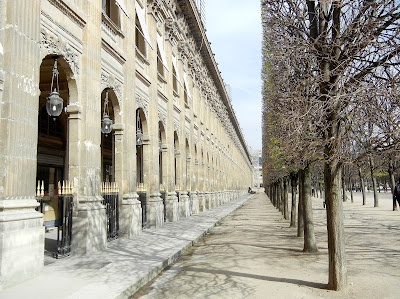We started at the corner of Rue de Rivoli and Rue du Louvre, at the eastern end of the Louvre Museum, where the 52 columns of Perrault’s Colonnade face the Place du Louvre. We walked a bit down the busy Rue de Rivoli and ran into the Temple de L'Oratoire, a Protestant church where behind the front columns a statue is dedicated to Admiral Gaspard de Coligny, a French admiral, nobleman, and Huguenot leader killed in the Saint Bartholomew's Day massacre. The massacre was directed against the Huguenots and took place a few days after the wedding of the king's sister Margaret to the Protestant Henry of Navarre (the future King Henry IV of France), who barely escaped assassination himself, when many of the wealthiest and most prominent Huguenots had gathered in largely Catholic Paris to attend the wedding.
In the back of the Palais is its famous Cour d'Honneur, which you access through one of the side entrances (we used the one on Rue de Valois). The Court is surrounded with columns and, since 1986, contains Daniel Buren's art installation known as Les Colonnes de Buren, which seems like a work in progress.
Behind this are the Palais Royal Gardens, a serene, park-like setting with its large fountain and perfectly manicured lawns. During the revolutionary period, Philippe d'Orléans, who became known as Philippe Egalité for his egalitarian political views, made himself popular in Paris when he opened the gardens of the palace to all Parisians. This is a really nice place to relax and take in the sun in the heart of Paris, but it's so secluded that you won't find it unless you're looking for it.
A small bronze cannon was installed in 1786 at the initiative of a Monsieur Rousseau, a watchmaker who had a shop in the gallery. It was installed on the Paris meridian and was used to adjust the clocks in Paris. Exactly at noon the sun's rays, passing through a lens, lit the cannon's fuse. It's been working on and off ever since.
The galleries on both sides and the north end of the gardens still have all kinds of antiques, art, and fashion shops, cafes, and restaurants, including the historic "Le Grand Vefour," where Napoleon and Josephine liked to dine, and which still maintains its beautiful 18th century setting.
In The Greater Journey: Americans in Paris, historian David McCullough mentions that of the adventurous American artists, writers, doctors, politicians, architects, and others who moved to Paris between 1830 and 1900, many ate at Le Vefour. He wrote: "The French seemed to take every meal in public, even breakfast, and whenever dining, showed not the slightest sign of hurry or impatience. It was as if they had nothing else to do but sit and chatter and savor what seemed to Americans absurdly small portions." It's comforting to know this sensible French custom hasn't changed.






















